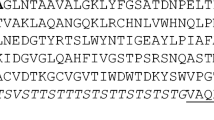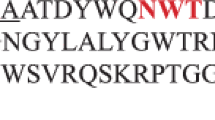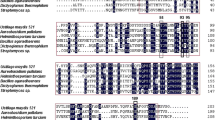Abstract
An extracellular endo-1,4-β-xylanase was purified from the culture supernatant of the ascomycete Aureobasidium pullulans ATCC 20524 grown on xylan. The purified enzyme was homogeneous as judged by sodium dodecyl sulphate–polyacrylamide gel electrophoresis and isoelectric focusing, which showed an apparent M r of 39 kDa and a pI of 8.9, respectively. Xylanase activity was optimal at pH 6.0 and 70°C. The genomic DNA and cDNAs encoding this protein were cloned and sequenced. The xylanase gene (xynII) encoded a 26 amino acid signal peptide and a 335 amino acid mature protein. DNA regions encoding the signal sequence and the mature protein were interrupted by introns of 56 and 73 bp, respectively. The xynII 5′-noncoding region had two consensus binding sites (5′-GCCARG-3′) for the transcription factor PacC mediating pH regulation. Quantitative real-time polymerase chain reaction analysis revealed that the transcription levels at pH 6.0 and 8.0 were 8-fold and 22-fold higher than that at pH 2.7, respectively. A cloned xynII cDNA was expressed and secreted in the yeast Pichia pastoris. Sequence alignment and phylogenetic analysis suggested that the XynII belongs to glycosyl hydrolase family 10 and that it is evolutionarily distant from two clusters formed by other family-10 xylanases.





Similar content being viewed by others
References
Akimoto H, Kiyota N, Kushima T, Nakamura T, Ohta K (2000) Molecular cloning and sequence analysis of an endoinulinase gene from Penicillium sp. strain TN-88. Biosci Biotechnol Biochem 64:2328–2335
Baba T, Shinke R, Nanmori T (1994) Identification and characterization of clustered genes for thermostable xylan-degrading enzymes, β-xylosidase and xylanase, of Bacillus stearothermophilus 21. Appl Environ Microbiol 60:2252–2258
Biely P, Vršanská M, Tenkanen M, Kluepfel D (1997) Endo-β-1,4-xylanase families: differences in catalytic properties. J Biotechnol 57:151–166
Blanco J, Coque JJR, Velasco J, Martín JF (1997) Cloning, expression in Streptomyces lividans and biochemical characterization of a thermostable endo-β-1,4-xylanase of Thermomonospora alba ULJB1 with cellulose-binding ability. Appl Microbiol Biotechnol 48:208–217
Cregg JM (1999) Expression in the methylotrophic yeast Pichia pastoris. In: Fernandez JM, Hoeffler JP (eds) Gene expression systems. Academic Press, New York, pp 157–191
Cubero B, Scazzocchio C (1994) Two different, adjacent and divergent zinc finger binding sites are necessary for CREA-mediated carbon catabolite repression in the proline gene cluster of Aspergillus nidulans. EMBO J 13:407–415
De Groot PWJ, Basten DEJW, Sonnenberg ASM, Van Griensven LJLD, Visser J, Schaap PJ (1998) An endo-1,4-β-xylanase-encoding gene from Agaricus bisporus is regulated by compost-specific factors. J Mol Biol 277:273–284
Deshpande MS, Rale VB, Lynch JM (1992) Aureobasidium pullulans in applied microbiology: a status report. Enzyme Microb Technol 14:514–527
Fukumura M, Sakka K, Shimada K, Ohmiya K (1995) Nucleotide sequence of the Clostridium stercorarium xynB gene encoding an extremely thermostable xylanase, and characterization of the translated product. Biosci Biotechnol Biochem 59:40–46
Gilkes NR, Henrissat B, Kilburn DG, Miller RC JR, Warren RAJ (1991) Domains in microbial β-1,4-glycanases: sequence conservation, function, and enzyme families. Microbiol Rev 55:303–315
Guex N, Peitsch MC (1997) SWISS-MODEL and the Swiss-PdbViewer: an environment for comparative protein modeling. Electrophoresis 18:2714–2723
Gurr SJ, Unkles SE, Kinghorn JR (1987) The structure and organization of nuclear genes of filamentous fungi. In: Kinghorn JR (ed) Gene structure in eukaryotic microbes. IRL Press, Oxford, pp 93–139
Haas H, Friedlin E, Stöffler G, Redl B (1993) Cloning and structural organization of a xylanase-encoding gene from Penicillium chrysogenum. Gene 126:237–242
Henrissat B (1991) A classification of glycosyl hydrolases based on amino acid sequence similarities. Biochem J 280:309–316
Henrissat B, Bairoch A (1993) New families in the classification of glycosyl hydrolases based on amino acid sequence similarities. Biochem J 293:781–788
Iikura H, Takashima S, Nakamura A, Masaki H, Uozumi T (1997) Cloning of a gene encoding a putative xylanase with a cellulose-binding domain from Humicola grisea. Biosci Biotechnol Biochem 61:1593–1595
Ito K, Ikemasu T, Ishikawa T (1992) Cloning and sequencing of the xynA gene encoding xylanase A of Aspergillus kawachii. Biosci Biotechnol Biochem 56:906–912
Kozak M (1989) The scanning model for translation: an update. J Cell Biol 108:229–241
Laemmli UK (1970) Cleavage of structural proteins during the assembly of the head of bacteriophage T4. Nature 227:680–685
Leathers TD (1986) Color variants of Aureobasidium pullulans overproduce xylanase with extremely high specific activity. Appl Environ Microbiol 52:1026–1030
Leathers TD (1989) Purification and properties of xylanase from Aureobasidium. J Ind Microbiol 4:341–348
Li XL, Ljungdahl LG (1994) Cloning, sequencing, and regulation of a xylanase gene from the fungus Aureobasidium pullulans Y-2311-1. Appl Environ Microbiol 60:3160–3166
Li XL, Ljungdahl LG (1996) Expression of Aureobasidium pullulans xynA in, and secretion of the xylanase from, Saccharomyces cerevisiae. Appl Environ Microbiol 62:209–213
Li XL, Zhang ZQ, Dean JFD, Eriksson KEL, Ljungdahl LG (1993) Purification and characterization of a new xylanase (APX-II) from the fungus Aureobasidium pullulans Y-2311-1. Appl Environ Microbiol 59:3212–3218
Li S, Cullen D, Hjort M, Spear R, Andrews JH (1996) Development of an oligonucleotide probe for Aureobasidium pullulans based on the small-subunit rRNA gene. Appl Environ Microbiol 62:1514–1518
Liu W, Saint DA (2002) A new quantitative method of real time reverse transcription polymerase chain reaction assay based on simulation of polymerase chain reaction kinetics. Anal Biochem 302:52–59
Lowry OH, Rosebrough NJ, Farr AL, Randall RJ (1951) Protein measurement with the Folin phenol reagent. J Biol Chem 193:265–275
MacCabe AP, Fernández-Espinar MT, de Graaff LH, Visser J, Ramón D (1996) Identification, isolation and sequence of the Aspergillus nidulans xlnC gene encoding the 34-kDa xylanase. Gene 175:29–33
MacCabe AP, Orejas M, Pérez-González JA, Ramón D (1998) Opposite patterns of expression of two Aspergillus nidulans xylanase genes with respect to ambient pH. J Bacteriol 180:1331–1333
Nakamura T, Shitara A, Matsuda S, Matsuo T, Suiko M, Ohta K (1997) Production, purification and properties of an endoinulinase of Penicillium sp. TN-88 that liberates inulotriose. J Ferment Bioeng 84:313–318
Nelson NJ (1955) Colorimetric analysis of sugar. Methods Enzymol 3:85–86
Ohta K, Moriyama S, Tanaka H, Shige T, Akimoto H (2001) Purification and characterization of an acidophilic xylanase from Aureobasidium pullulans var. melanigenum and sequence analysis of the encoding gene. J Biosci Bioeng 92:262–270
O'Neill G, Goh SH, Warren RAJ, Kilburn DG, Miller RC Jr (1986) Structure of the gene encoding the exoglucanase of Cellulomonas fimi. Gene 44:325–330
Pañalva MA, Arst HN Jr (2002) Regulation of gene expression by ambient pH in filamentous fungi and yeast. Microbiol Mol Biol Rev 66:426–446
Peitsch MC (1995) Protein modeling by e-mail. Biotechnology (N.Y.) 13:658–660
Pell G, Szabo L, Charnock SJ, Xie H, Gloster TM, Davies GJ, Gilbert HJ (2004) Structural and biochemical analysis of Cellvibrio japonicus xylanase 10C. J Biol Chem 279:11777–11788
Puls J, Schuseil J (1993) Chemistry of hemicelluloses: relationship between hemicellulose structure and enzymes required for hydrolysis. In: Coughlan MP, Hazlewood GP (eds) Hemicellulose and hemicellulases. Portland Press, London, pp 1–27
Sambrook J, Russel DW (2001) Molecular cloning: a laboratory manual, 3rd edn. Cold Spring Harbor Laboratory Press, New York
Sato Y, Niimura Y, Yura K, Go M (1999) Module-intron correlation and intron sliding in family F/10 xylanase genes. Gene 238:93–101
Schmidt A, Schlacher A, Steiner W, Schwab H, Kratky C (1998) Structure of the xylanase from Penicillium simplicissimum. Protein Sci 7:2081–2088
Schwede T, Kopp J, Guex N, Peitsch MC (2003) SWISS-MODEL: an automated protein homology-modeling server. Nucleic Acids Res 31:3381–3385
Somogyi M (1952) Notes on sugar determination. J Biol Chem 195:19–23
Tanaka H, Okuno T, Moriyama S, Muguruma M, Ohta K (2004) Acidophilic xylanase from Aureobasidium pullulans: efficient expression and secretion in Pichia pastoris and mutational analysis. J Biosci Bioeng 98:338–343
Tull D, Withers SG, Gilkes NR, Kilburn DG, Warren RAJ, Aebersold R (1991) Glutamic acid 274 is the nucleophile in the active site of a “retaining” exoglucanase from Cellulomonas fimi. J Biol Chem 266:15621–15625
van Peij NNME, Gielkens MMC, de Vries RP, Visser J, de Graaff LH (1998) The transcriptional activator XlnR regulates both xylanolytic and endoglucanase gene expression in Aspergillus niger. Appl Environ Microbiol 64:3615–3619
Wu S-C, Kauffmann S, Darvill AG, Albersheim P (1995) Purification, cloning and characterization of two xylanases from Magnaporthe grisea, the rice blast fungus. Mol Plant-Microb Interact 8:506–514
Acknowledgements
We thank Prof. Tatsuo Nakayama of Miyazaki Medical College for the N-terminal amino acid sequencing. This study was supported in part by The Iwatani Naoji Foundation's Research Grant 2003.
Author information
Authors and Affiliations
Corresponding author
Rights and permissions
About this article
Cite this article
Tanaka, H., Muguruma, M. & Ohta, K. Purification and properties of a family-10 xylanase from Aureobasidium pullulans ATCC 20524 and characterization of the encoding gene. Appl Microbiol Biotechnol 70, 202–211 (2006). https://doi.org/10.1007/s00253-005-0045-3
Received:
Revised:
Accepted:
Published:
Issue Date:
DOI: https://doi.org/10.1007/s00253-005-0045-3




